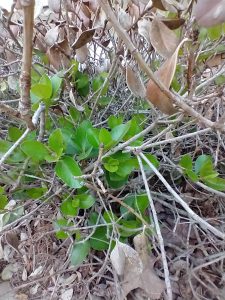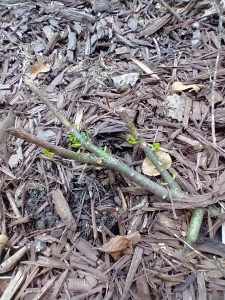Heather N. Kolich, ANR Agent, UGA Extension Forsyth County
Last month, I recommended renewal pruning for broadleaf shrubs showing signs of freeze injury. I applied this advice in late March to a gardenia hedge that turned black after the December deep-freeze, cutting the stems back severely until I found living tissue. I expected to see leaf buds within the first three weeks of April. The weather, of course, always has a say in these matters, and the cool April temperatures kept the soil too cold to stimulate plant roots into action. I’m pleased to report, however, that new leaves began sprouting this week.


I’ve also seen new leaves growing low on the stems of Indian hawthorns and other shrubs that survived December, only to get injured with the three March freezes. These will need pruning soon to remove the dead stems above the new growth.
Shrubs aren’t the only landscape plants showing slow green-up this season. University of Georgia turfgrass specialist Clint Waltz has seen delayed greening and growth in warm-season turfgrasses throughout Georgia. Below is his recent blog post.
Warm-season Grass Green-up
By Clint Waltz, Ph.D.
University of Georgia Turfgrass Specialist
As a University of Georgia Cooperative Extension turfgrass specialist, I have received numerous calls and emails over the past couple of weeks regarding warm-season turfgrass “green-up” issues.
Fortunately, my travel schedule has taken me statewide over the past month. I have had the opportunity to see grass over an array of Georgia’s climatic conditions (i.e., South to North Georgia). Most years, slow growth is not as consistent statewide as it has been this year.
Simply stated, green-up of warm-season turfgrass has been stalled through most of March, April and first week of May. Despite the low temperatures associated with the “Christmas Freeze” (December 23 to 26, 2023), December, January, and February were relatively warm, giving a false sense of an early spring green-up. When March cool temperatures arrived, grass growth stalled.
From what I have seen statewide since the “Christmas Freeze”, I am not convinced that this particular weather event had a long-term or detrimental effect on warm-season turfgrasses. The most recent conditions are more likely influencing spring green-up and growth. Here’s what happened in early 2023:
- Using data and observations from the UGA Griffin Campus weather station as an indicator, during March and April there was only one night (April 6) where the low temperature did not fall below 65 degrees Fahrenheit.
- There were three (3) frost events in March (15, 16, and 21).
- From April 30 through May 5, the low temperatures were in the 40’s – six (6) consecutive nights. These conditions resulted in 4-inch soil temperatures struggling to reach the mid-60’s, when warm-season turfgrasses initiate rooting and active growth.
- My comments to the calls and emails have been that our grasses have been “sitting on go” just waiting for favorable environmental conditions.
Our grasses have been green but not growing up (e.g., no clippings) or filling-in thin areas. I have complaints from sod producers, landscapers, and homeowners of grass not responding to fertilizer applications. Considering the air and soil temperatures of March and April, these complaints are not surprising or agronomically unfounded. It can be difficult, and frustrating, to tell clients that there is not much we can do but be patient, and let’s reevaluate in a few weeks once the environmental conditions become more favorable for growth.
Temperatures this week (May 7 to present) have been more conducive for growth and the 10-day forecast is encouraging. Warm daytime and nighttime temperatures are what the doctor ordered.
Going forward, maintain the basic agronomics for the growth of warm-season turfgrasses. Maintaining proper mowing heights, not over-irrigating, and applying proper fertility are good practices and will pay dividends as we move from spring to summer.